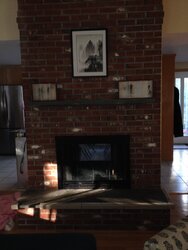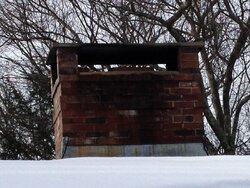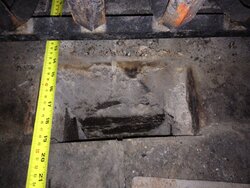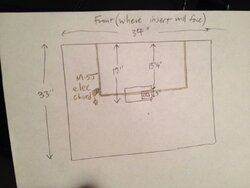I'm going to install an Enviro M-55 into a double-sided masonry fireplace [pictured below], which runs up 12' w/in the house, then visibly 3' above the roof, and is topped by a piece of slate.


I've gratefully read the debates & links on this board for both sides of the great OAK debate; I've determined that I will get one.
I'm stumped re: where to get the outdoor air from when installing an OAK. I'm in the middle of getting quotes from dealers & figuring out who will do the install. I asked about this for the first time recently of one dealer. I think he wasn't sure either how to set up an OAK in this context; his answers made me think that there's no totally clear solution. Before committing, I'd welcome help from y'all who have experience w/ your own OAKs and/or who help others install OAKs.
Part of the challenge seems to be the large piece of slate that protects my two flues and chimney from precipitation [see picture above]. My wife and I think that slate is more effective and more visually appealing than permanently getting rid of it and installing a metal rain guard above the furnace flue and a tall Selkirk DT style top above the chimney flue that would separate the exhaust and air intake by 12". [ see https://www.hearth.com/talk/attachments/dtmetalchimneyadapter-jpg.90960/ for one diagram showing the top; see http://www.selkirkcorp.com/WorkArea/showcontent.aspx?id=8420 for details.] I understand that we'll have to at least temporarily take the slate off to drop an exhaust liner down the chimney flue.
The slate is maybe 8" above the chimney, so I can't space/fit both intake and exhaust vertically while keeping this slate, the way the Selkirk would let me do.
Here are options I'm aware of:
Plan A: run the standard 3" flexible venting to suck in outdoor air from the M-55 12-14' straight up to the piece of flat steel that will cap my chimney at the top and hold up the exhaust venting and air intake at the top of the chimney flue. Where these two pipes terminate would definitely be less than 12" away from each other, and I've read elsewhere on this board that you shouldn't do that and/or it violates code, in which case I definitely don't want this; there's also a second flue from a furnace that will sometimes exhaust more oxygen-depleted air in that covered area.
Plan B: run the standard 3" flexible venting up to the top of the chimney but then have it make U and snake down one side of the chimney. Rig up some kind of brick surround, perhaps, to hide it in what looks like an addition to chimney...but the bricks would inevitably look different from what is already there...
Plan C: run the 3" piping down the fireplace cleanout, i.e., the ash chute in the middle of our doublesided fireplace [see picture]. It will either just fit [see diagram of fireplace with lines showing where M-55 will overlap with ash chute but leave just about 3"].


The flexible venting would:
1. run about 10' down,
2. make a U turn at the bottom of the ash chute and run 7' back up to the ceiling
3. make 3 right-angle turns and run a total of 12' to get to an outside wall
4. terminate in a hole we'd make for it to get outside air where the cement meets the wooden part of our house...that's 9" above ground level; is that OK when there's snow? I have the sense that this is what is done for combustion air for oil furnaces, and assume they still draw air...
I'd welcome advice, solutions that have worked--or not--for others, questions, or info about OAKs that I'm missing--thank you!


I've gratefully read the debates & links on this board for both sides of the great OAK debate; I've determined that I will get one.
I'm stumped re: where to get the outdoor air from when installing an OAK. I'm in the middle of getting quotes from dealers & figuring out who will do the install. I asked about this for the first time recently of one dealer. I think he wasn't sure either how to set up an OAK in this context; his answers made me think that there's no totally clear solution. Before committing, I'd welcome help from y'all who have experience w/ your own OAKs and/or who help others install OAKs.
Part of the challenge seems to be the large piece of slate that protects my two flues and chimney from precipitation [see picture above]. My wife and I think that slate is more effective and more visually appealing than permanently getting rid of it and installing a metal rain guard above the furnace flue and a tall Selkirk DT style top above the chimney flue that would separate the exhaust and air intake by 12". [ see https://www.hearth.com/talk/attachments/dtmetalchimneyadapter-jpg.90960/ for one diagram showing the top; see http://www.selkirkcorp.com/WorkArea/showcontent.aspx?id=8420 for details.] I understand that we'll have to at least temporarily take the slate off to drop an exhaust liner down the chimney flue.
The slate is maybe 8" above the chimney, so I can't space/fit both intake and exhaust vertically while keeping this slate, the way the Selkirk would let me do.
Here are options I'm aware of:
Plan A: run the standard 3" flexible venting to suck in outdoor air from the M-55 12-14' straight up to the piece of flat steel that will cap my chimney at the top and hold up the exhaust venting and air intake at the top of the chimney flue. Where these two pipes terminate would definitely be less than 12" away from each other, and I've read elsewhere on this board that you shouldn't do that and/or it violates code, in which case I definitely don't want this; there's also a second flue from a furnace that will sometimes exhaust more oxygen-depleted air in that covered area.
Plan B: run the standard 3" flexible venting up to the top of the chimney but then have it make U and snake down one side of the chimney. Rig up some kind of brick surround, perhaps, to hide it in what looks like an addition to chimney...but the bricks would inevitably look different from what is already there...
Plan C: run the 3" piping down the fireplace cleanout, i.e., the ash chute in the middle of our doublesided fireplace [see picture]. It will either just fit [see diagram of fireplace with lines showing where M-55 will overlap with ash chute but leave just about 3"].


The flexible venting would:
1. run about 10' down,
2. make a U turn at the bottom of the ash chute and run 7' back up to the ceiling
3. make 3 right-angle turns and run a total of 12' to get to an outside wall
4. terminate in a hole we'd make for it to get outside air where the cement meets the wooden part of our house...that's 9" above ground level; is that OK when there's snow? I have the sense that this is what is done for combustion air for oil furnaces, and assume they still draw air...
I'd welcome advice, solutions that have worked--or not--for others, questions, or info about OAKs that I'm missing--thank you!

